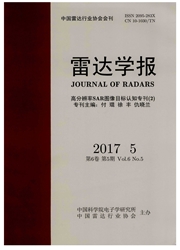

 中文摘要:
中文摘要:
双基地雷达中引入多输入多输出(MIMO)技术,可以从接收数据中获取双基地雷达发射角度信息。这一新增的角度信息用于空时自适应处理,获得发射空间-接收空间和多普勒3维杂波谱。该文旨在对双基地MIMO雷达空时自适应处理抑制杂波方法进行综述。首先介绍了双基地MIMO雷达信号模型,然后介绍了几种正侧视双基地MIMO雷达空时3维自适应处理方法(3D-STAP),包括3维线性最小方差(3D-LCMV)方法、3维辅助通道方法、3维局域化联合处理以及3维投影的空时3维降维杂波抑制方法,仿真分析表明这些降维方法能够有效提高小样本条件下的双基地MIMO雷达距离依赖杂波抑制性能。最后,对双基地MIMO雷达空时自适应处理研究做了总结和展望。
 英文摘要:
英文摘要:
The transmit angle of bistatic radars can be obtained by introducing Multiple-Input Multiple-Output (MIMO) radar techniques. The Three-Dimensional (3D) clutter spectra, that is, the transmit angle, receive angle, and Doppler frequency, are introduced using the additional angle information to Space-Time Adaptive Processing (STAP). This study reviews the researches on bistatic MIMO-STAP. 3D space-time adaptive processing methods for airborne bistatic side-looking MIMO radars, such as 3D-LCMV, 3D-ACR, 3D-JDL, and 3D projection-based reduced dimensional STAP methods, are discussed. Simulation results show that the proposed methods can improve the small-sample support performance of range-dependent clutter suppression in bistatic side-looking MIMO radar. Finally, the results are summarized and the prospects of bistatic MIMO-STAP are discussed.
 同期刊论文项目
同期刊论文项目
 同项目期刊论文
同项目期刊论文
 期刊信息
期刊信息
